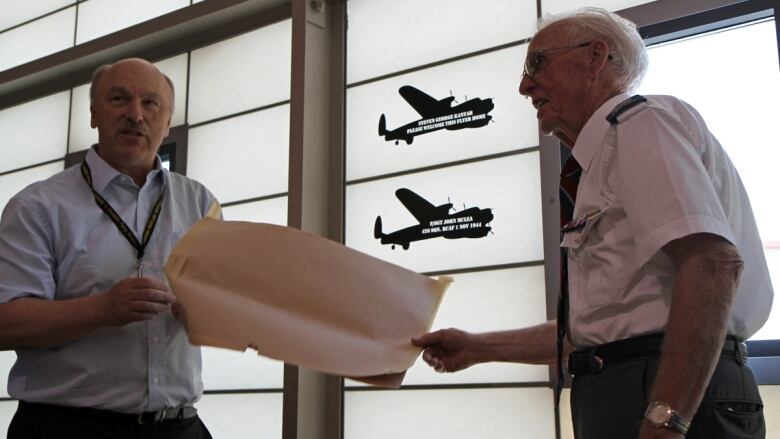70 years on, Air Force vet meets missing friend's family
John McLea, of Hamilton, disappeared in 1944 after his plane crashed in Germany

Seventy years after his friend and fellow airman went missing behind enemy lines, Fraser Muir got his wish.
At a ceremony at the Canada Warplane Heritage Museum in Hamilton, the Second World War veteran finally met the family of John McLea, a local man and Royal Canadian Air Force tailgunner who disappeared in November 1944 when his Halifax bomber crashed in Germany.
The Sunday event, which saw Muir, 89, help to dedicate a frosted glass plaque in his fallen friends honour, culminates a decades-long search to find and meet with McLeas relatives.

Its an answer to a prayer, said Muir, who met McLea at basic training in P.E.I. when the two were still in their teens. I feel on top of the world.
McLea, Muir said, bragged about Hamilton and spoke often about how much he looked forward to returning to his hometown.
So in the years since McLeas disappearance, "Iwould ask everybody from Hamilton if they knew John or knew of the family," said Muir, a resident of Wasaga Beach.
But nobody did until this year.
A back-and-forth over email with staff at the Hamilton Military Museum led Muir to learn of one of McLeas nephews, Air Canada pilot and Warplane Heritage museum volunteer John McClenaghan.
Three months ago, Muir rang up the 60-year-old up and told him about his search for McLeas family and the time in 1999 when he sprinkled soil from the Hamilton Mountain by the gravestone in Germany engravedwith the missing mans name.
In the hour-and-half call, McClenaghan, of Etobicoke, spoke of his own research on what became of his namesake uncle, whom he never met.
Emotional encounter
The two men metface-to-face for the first time at the plaque dedication on Sunday, and McClenaghan treated the 50 or so people in attendance to a presentation on McLeaslife.
Its pretty special, said McClenaghan. Im having trouble just not breaking down when I talk about.

He estimated that most of the people who came out were either relatives of his some close, some he didn't recognize or history buffs who learnedabout Muir's storyfromthe news.
McLeas last surviving sibling, Ancasters Margaret Stephenson, was on hand at the ceremony. She said she was 14 when a telegram arrived at her house notifying the McLea family about her brothers disappearance.
It makes me feel kind of teary-eyed, Stephenson said of Muirs story. "And I'm trying not to do that."
But she noted the heartbreak and uncertainty of having a sibling, child or spouse disappear overseas was a common experience during the Second World War.
So many families had someone go missing."
With files from Adam Carter












_(720p).jpg)


 OFFICIAL HD MUSIC VIDEO.jpg)
.jpg)



























































































